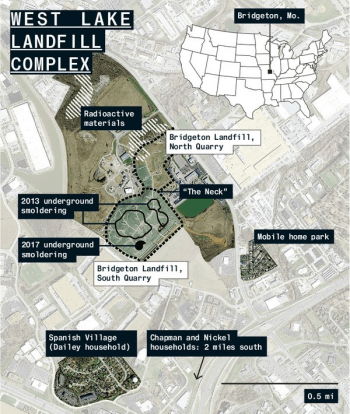Above: “Barrel Mountain” by Jason Hargrove was inspired by his visit to the Weldon Springs toxic waste containment site where uranium was processed and stored.
On February 1, the EPA released a record of the decision announcing its new proposal to remove radioactive waste from the West Lake Landfill. This removal strategy proposes the excavation of 67 percent of the radioactive waste to a maximum depth of 16 feet, the installation of an engineered cap to cover the remaining wastes, institutional controls, and monitoring. To some, this decision marks a victory in a long citywide struggle with radioactive waste; to others this plan does not go far enough to protect residents from the dangers of radioactivity. Minimizing the risk of exposure to radioactivity for workers and the underground smoldering event at the nearby Bridgeton Landfill were factors that the EPA had to consider when formulating a plan for waste removal.
The cleanup of the radioactive waste will consist of several stages; it is projected to take 5 years. The EPA has issued a public comment period that extends through April 23 and intends to collect public input on the thoroughness of the removal, the differentiation of excavation strategies between waste areas, and the destination of the radioactive material after removal.
The West Lake Landfill Site

St. Louis’s role in the atomic age culminated in the radioactive waste being deposited in various sites around St. Louis, with the West Lake Landfill being one of them. The Bridgeton/West Lake Landfill is situated north of the St. Louis Lambert Airport and south of the Missouri River. The radioactive waste at the West Lake Landfill sits about 600ft away from an underground smoldering event in the same quarry basin at the Bridgeton Landfill, resulting in a risk that the underground fire reaches the radioactive waste. Additionally, health concerns remain for residents as improperly contained radioactive material leaching out of the landfill site can significantly impact the health of exposed populations. Cancer, thyroid disease, and tumor development in the brain and nervous system have been identified in clusters surrounding Coldwater Creek, an area that has been exposed to radioactive waste contamination for 25 years.
A History of Radioactivity
The following events offer a brief look back at the radioactive history of the West Lake Landfill. During World War 2, Mallinckrodt Chemical Works processed uranium at a site in downtown St. Louis for US government nuclear weapon research and development. Throughout the next 25 years, the radioactive waste byproduct was moved to sites throughout North County. A temporary storage site at the airport was used to contain some of the waste, contaminating soil and water along St. Charles Rock Road. After the dumping of an estimated 43,000 tons of radioactive waste and contaminated dirt at the West Lake Landfill in 1973, the Nuclear Regulatory Commission inspected the landfill site and declared it non-hazardous. Nearly fifteen years later, the site was reevaluated and the Commission called for the removal of the radioactive waste due to contamination in the groundwater. In 1990, the West Lake Landfill was put on the national priorities superfund list, and a remedy capping strategy was proposed by the EPA in 2006. Resident concerns about the effectiveness of this strategy to mitigate contaminated groundwater remained high. In 2010, an underground fire due to chemical reactions at the Bridgeton Landfill was discovered creeping towards the radioactive waste. Concerns about the potentially catastrophic outcome of the fire meeting the radioactive waste put additional pressure on the importance of removal and remediation.
Local Perspectives and Efforts
Just Moms STL, non-profit organization founded in 2013 by local residents, soon became the main activist group advocating for the removal of the radioactive material at the West Lake Landfill. The group calls for the relocation of residents living within a mile of the landfill in the form of a buyout program to eliminate their risk of exposure during the removal process. They also call for offsite storage at a licensed nuclear facility as is being done with the waste at Coldwater Creek. Finally, they urge the percent of removal to be increased to the highest possible amount.
In partnership with Just Moms STL, WashU student group Green Action has been advocating for the cleanup of the landfill. Channing Hunter, member of Green Action, states that “Green Action is helping the community through data analysis, and outreach through education and activism here on campus and in the greater St. Louis area. We have submitted documents to the EPA, have members on the Community Advisory Group, and work with the EPA to help characterize the site to foster a greater understanding of the potential hazards to the community, and potential solutions to minimizing their negative impacts through the remediation process.” Contact Green Action for questions about student involvement concerning West Lake Landfill.
Further learning:
Atomic Homefront is a documentary that tells a thorough story of the site and documents those who have mobilized to get answers, created a powerful coalition and continue to fight for environmental justice. FREE SCREENING AT WASHU on April 7 and 14.
To read the EPA’s record of decision, read this document.
To learn more about this complex site and its history check out this article from the St. Louis Post-Dispatch and the Just Moms STL website.
This article was written by communication intern, Kristen Patino.